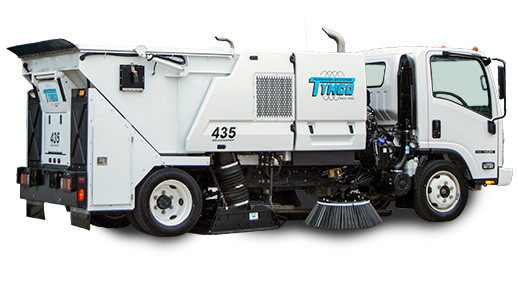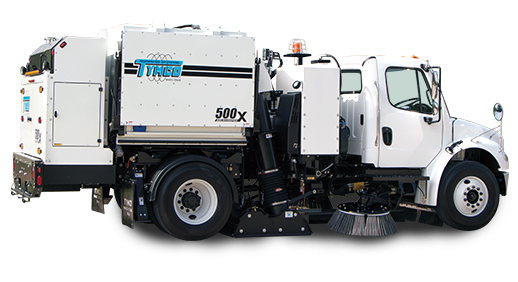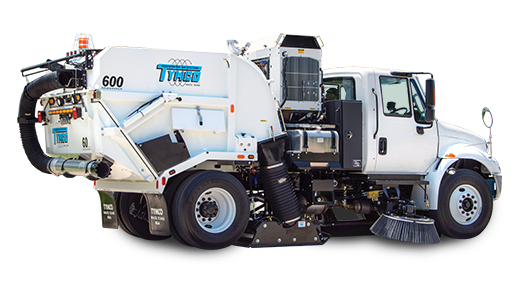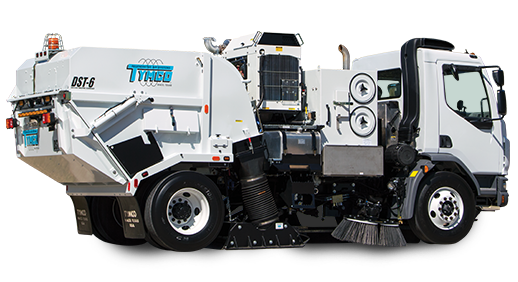High Speed Airport Runway Sweeping
From private airports and heliports to the busiest international airports, it is very important for the airport runways, ramps, aprons and taxiways to remain clean and clear of any debris that could potentially be classified as Foreign Object Debris (FOD).
According to National Aerospace FOD Prevention, FOD is a substance, debris or article alien to a vehicle or system that has potential to cause damage.1 This means that FOD could potentially be any material and any size, sometimes smaller than what can be seen by just glancing out over an open airfield. Because of the potential of Foreign Object Damage (FOD), most airports conduct routine FOD checks where airport personnel will drive back and forth over the runways and taxiways looking for FOD. Many airports have personnel dedicated to operating sweepers on the airfield to sweep all debris while they perform their routine checks for larger FOD.
FOD costs the aerospace industry $1.1-$2 billion USD per year in direct costs, and as much as ten times that amount in indirect costs from delays, aircraft changes, incurred fuel costs and unscheduled maintenance for a total of $12 billion USD per year.2
- National Aerospace Standard (NAS) 412, maintained by National Aerospace FOD Prevention, Inc.
- “The Economic Cost of FOD”. Insight SRI Ltd. Retrieved 2009-12-09.
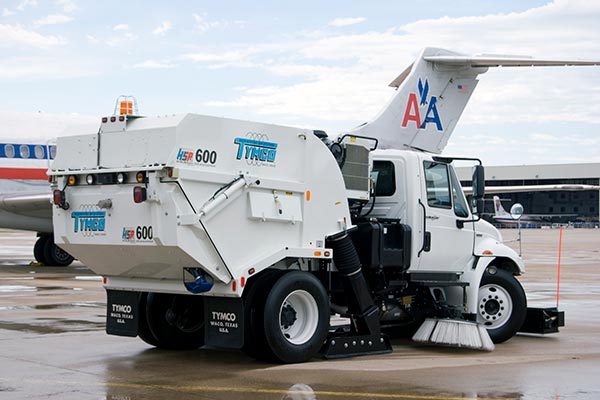
Considering the high cost of damage that can be done by FOD that might not be any bigger than a piece of safety wire, not to mention any potential injuries from FOD, airport administration should seriously consider implementing routine sweeping as a Best Management Practice (BMP) to reduce FOD at their airfields.
TYMCO Airport Sweepers
Runway
High Speed Airport Runway Sweeping
Every year, more and more people are using air transportation as their means to travel. Meanwhile, airport administrators are trying to increase air traffic without adding additional resources. This makes time extremely valuable for all activities performed by airport personnel. When airport maintenance staff perform routine sweeping over runways, ramps, aprons and taxiways, it is critical that those areas are swept to remove all FOD, but it is becoming increasingly important for those areas to be swept quickly. TYMCO originally designed the Model HSP® (High Speed Performance) for the United States Military to meet their High Speed Runway Sweeper Performance Specification requiring 6 different tests over 140 sq ft on a flat level paved area.
- Sand Test – 0.5 lbs/sq ft with a Required Performance of 95% at 15 mph
- Pea Gravel Test – 0.5 lbs/sq ft with a Required Performance of 95% at 15 mph
- Stone Test – Ten Stones having a 2” nominal diameter with a Required Performance of 100% at 15 mph
- Solid Steel Cylinder Test – Ten Solid Steel Cylinders 1” in diameter x 3” long with a Required Performance of 100% at 15 mph
- Joint Cleaning Test – 1/2″ x 1/2″ x 6-1/2’ long joint filled with sand with a Required Performance of 40% at 15 mph
- Miscellaneous Pick Up Test – Seven each of the following items placed on the track. Required Performance of 54 pcs at 15 mph.
- Steel
- Balls – 1/2″ diameter
- Nails – 2-1/2” long
- Flat Washers – 1/2 I.D.
- Screw Cap – 1/4″ diameter x 2”
- Hexagon Nut – 1/2″
- Air Craft Safety Wire – 1/2″ long, crumpled
- Aluminum
- Sheet – 2” sq x 1/8” thick
- Rivets – 1/4″ diameter x 1”
- Steel
The Model HSP was developed by TYMCO to meet the United States Military’s High Speed Runway Sweeper Performance Specification MIL-C-29195(YD). Because of the excellent performance of the Model HSP, it soon became the desired airport runway sweeper of civilians as well as military airports worldwide.
Stormwater
A Stormwater Runoff Best Management Practice (BMP)
There is always that next project – building an area for cars and trucks that are waiting to pick up passengers, adding airports services for travelers, expanding the terminals. You name it and it is on the list. But in light of all the projects that need to get done, you still have to maintain what you have now and keep it looking great. TYMCO builds sweepers to keep your entire airport looking its best. From all of the internal streets and roads connecting terminals, loading and unloading areas, parking garages and remote parking lots as well as runways, TYMCO builds a sweeper to keep your airport clean.
Airports are required to implement a number of Best Management Practices (BMPs) for stormwater management. There are several different BMPs that can be implemented such as adding additional landscaping, installing storm drain catch basins and sweeping paved surfaces on a frequent basis. Sweeping airport runways, ramps and aprons on a regular basis obviously keeps the larger debris from going down storm drains, but sweeping with a TYMCO Regenerative Air Sweeper will also remove all of the fine dust particulates out of the cracks and crevices.
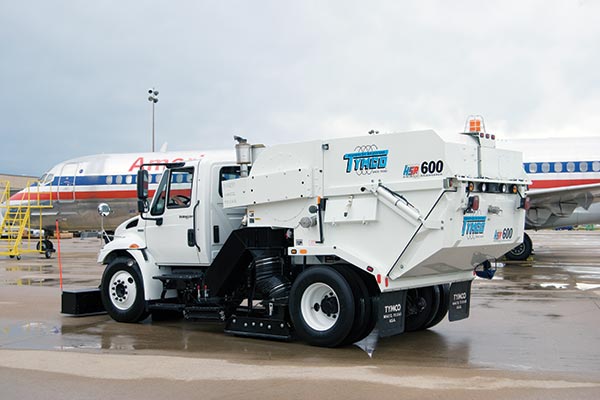
More often than not, fine dust particulates can be more damaging to stormwater runoff than larger debris. This dust can contain several different contaminants and toxins like vehicle lubricants, coolants and brake dust, petroleum products used in pavements as well as other contaminants that fall on parking area, apron and taxiway surfaces. Whenever there is a rain event, anything left on the paved surface will be picked up by the stormwater runoff and flow into local waterways.
Glycol Recovery
Glycol Recovery
Today more than ever, airport management is looking for ways to leverage the most out of every piece of equipment that is purchased for their airport. With the need to keep airport runways, ramps, aprons and staging areas clear of Foreign Object Debris (FOD) as well as increased pressure from environmental regulations requiring airports to eliminate deicing fluid runoff, airports are buying more and more equipment to help them get their jobs done quickly and more efficiently. Some environmental regulators propose that airports construct centralized deicing pads to assist in complying with environmental requirements. Because of space constraints and expense, changing an airport’s flight workflow around a centralized deicing pad isn’t always feasible. Using a glycol recovery system such as the Model HSP® or Model 600® equipped with the TYMCO Liquid Recovery System (LRS) helps airports meet environmental regulations while controlling expenses. Plus, you can also use your new TYMCO to sweep your runways and taxiways – making it a piece of equipment used year-round.
Your TYMCO is also a Glycol Recovery Vehicle
When partnered with TYMCO’s Liquid Recovery System (LRS), a TYMCO Model HSP or Model 600 can also be used to recover glycol or other deicing fluids from airport ramps, aprons, gates and staging areas. From the comfort of the truck chassis, the operator can use their TYMCO to “sweep up” all of the glycol or deicing fluid that collects around aircraft waiting to depart along with any debris in the area.
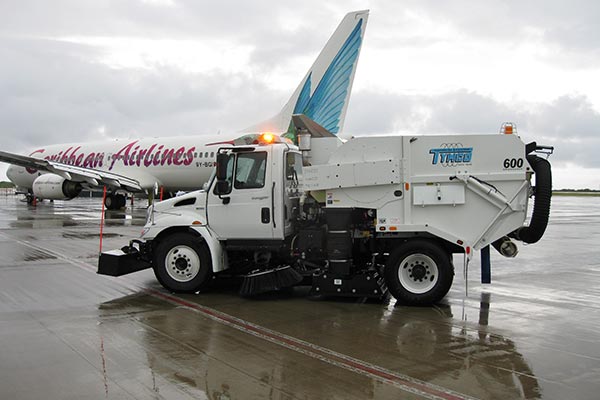
The operator can then travel to an area where the airport stores used glycol and pump off all of the deicing fluid accumulated inside the TYMCO hopper while leaving the majority of other debris swept up inside the hopper for dumping. The Model HSP and Model 600 can collect over 700 gallons of liquid and can easily change from a glycol recovery vehicle back to an airfield sweeper. There are no components that the operator needs to change to switch from sweeping paved surfaces to glycol recovery.
U.S. Military
TYMCO and the U.S. Military
In the late 1970s, the United States Air Force (USAF) researched several existing sweeper technologies to find a single sweeper to provide both airfield and airbase sweeping. Because of specific changes in aircraft and Ground Support Equipment (GSE), the U.S. Air Force was demanding that a sweeper provide a faster, more efficient way to sweep all areas of the airbase – runways, ramps, base streets and construction areas. In addition to locating a newer technology, the USAF made an effort to reduce the overall sweeper inventory of both airfield and airbase sweepers by developing Multipurpose Sweeper Specification PD WR-ALC/IRA 3825-093 that would meet the rigorous testing requirements of both high performance and low total cost of ownership.
In 1982, TYMCO was fortunate to be part of the U.S. Air Force MEEP (Management and Equipment Evaluation Program) Multipurpose Sweeper Test and after extensive evaluation of several technologies, the USAF developed Multipurpose Sweeper Specification PD WR-ALC/TRA 3825-093A around the TYMCO Model 600® and the TYMCO Regenerative Air System. Over the last 30 years, hundreds of TYMCO Regenerative Air Sweepers have been purchased by all branches of the U.S. Military as well as several international military groups. In addition, the Department of Defense (DOD) has made TYMCOs available through Foreign Military Sales (FMS). FMS has provided TYMCO the opportunity to supply sweepers to military groups in other countries such as Greece, Taiwan and Egypt. Although the TYMCO Model 600 exceeded the Multipurpose Sweeper Specification, the United States Navy, Air Force and Army demanded that an airfield sweeper be developed that could remove Foreign Object Debris (FOD) out of the cracks and crevices of runway pavement using the full width of the pick-up head at much faster sweeping speeds than the Model 600 was delivering. Their needs called for a high speed runway sweeper that DID NOT REQUIRE a mechanical main broom to sweep at faster speeds. A mechanical main broom not only increased operational costs by adding an additional wear item, but also could inherently create FOD with bristles that could fall out or break off while sweeping. TYMCO answered the U.S. Military’s need for a high speed runway sweeper with a new class of sweeper, the TYMCO Model HSP® (High Speed Performance), which was designed to meet the U.S. Military’s High Speed Runway Sweeper Performance Specification MIL-C-29195(YD).
The U.S. Air Force, Navy, Marines, Army and Coast Guard have discovered the high performance and low total cost of ownership that TYMCO Regenerative Air Sweepers deliver, which is why the majority of the U.S. Military’s sweepers are TYMCOs. TYMCO has supplied both the Model 600 and the Model HSP to the U.S. Military – with hundreds of units currently serving, and hundreds more serving international military groups worldwide. Other sweepers may meet military specifications, but TYMCOs exceed their expectations on and off the runway.

